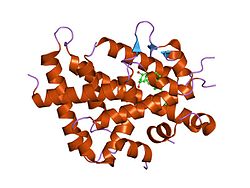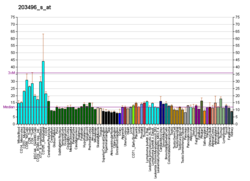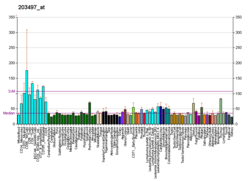Mediator of RNA polymerase II transcription subunit 1 also known as DRIP205 or Trap220 is a subunit of the Mediator complex and is a protein that in humans is encoded by the MED1 gene.[5][6][7] MED1 functions as a nuclear receptor coactivator.
| Med1 | |||||||||
|---|---|---|---|---|---|---|---|---|---|
| Identifiers | |||||||||
| Symbol | Med1 | ||||||||
| Pfam | PF10744 | ||||||||
| InterPro | IPR019680 | ||||||||
| |||||||||
Function
The activation of gene transcription is a multistep process that is triggered by factors that recognize transcriptional enhancer sites in DNA. These factors work with co-activators to direct transcriptional initiation by the RNA polymerase II apparatus. The mediator of RNA polymerase II transcription subunit 1 protein is a subunit of the CRSP (cofactor required for SP1 activation) complex, which, along with TFIID, is required for efficient activation by SP1. This protein is also a component of other multisubunit complexes [e.g., thyroid hormone receptor-(TR-) associated proteins that interact with TR and facilitate TR function on DNA templates in conjunction with initiation factors and cofactors]. It also regulates p53-dependent apoptosis and it is essential for adipogenesis. This protein is known to have the ability to self-oligomerize.[7]
Interactions
MED1 has been shown to interact with:
Protein family
This entry represents subunit Med1 of the Mediator complex. The Med1 forms part of the Med9 submodule of the Srb/Med complex. It is one of three subunits essential for viability of the whole organism via its role in environmentally-directed cell-fate decisions.[21]






